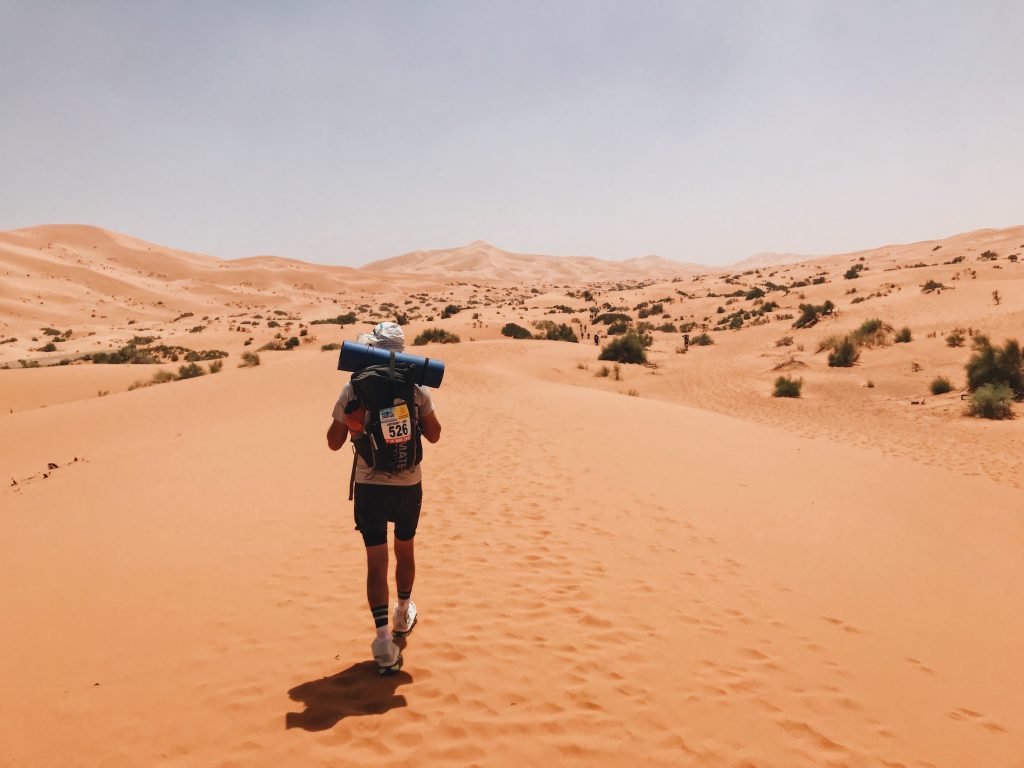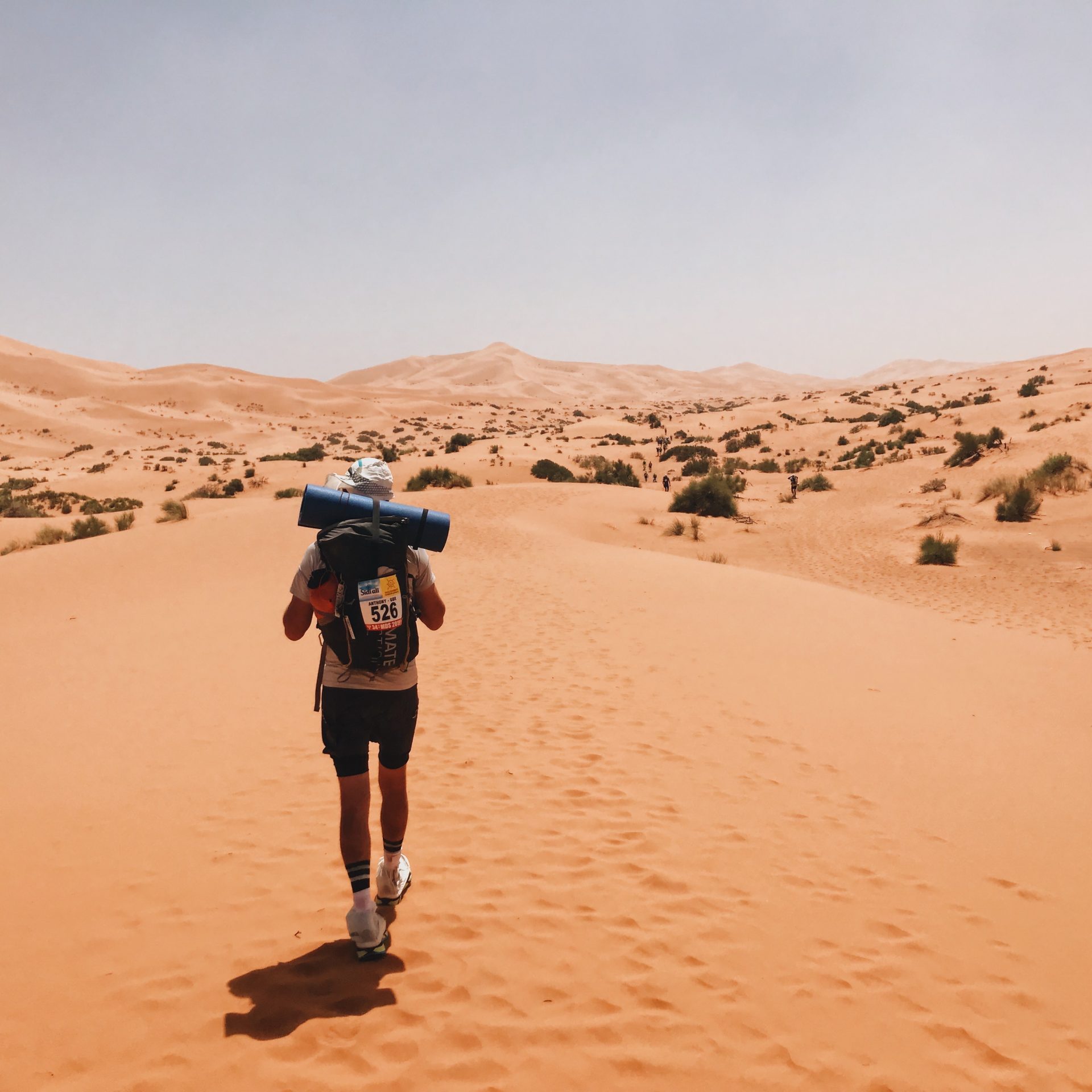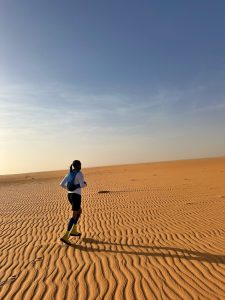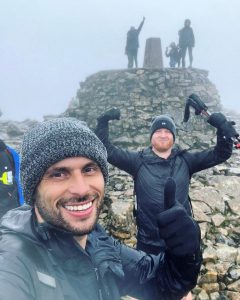The Marathon des Sables, known as “Marathon of Sands” in French, is a rite of passage for serious ultra-runners and also people like myself who aren’t ardent (or particularly gifted) athletes but do have a thirsty desire to see if they tough enough for such challenges.
Well, they don’t come much more difficult than this event, which is commonly referred to as “the toughest footrace on earth.”
Are you also considering MDS and wondering if you are tough enough?
Read this (long and detailed) Marathon des Sables experience and I’ll explain every bit of detail that I wish I knew before last-minute agreeing to take on this beast so that you don’t make it unnecessarily harder than it already is and I’ll round up the post with an open and honest account of my very own highway to hell in the brutal Sahra Desert.
What Exactly is The Marathon des Sables?
The Marathon des Sables is a 10-day endurance event (including administration) where participants run an accumulation of 6 marathons in 6 days in the sweltering hot Shara Desert.
Each participant has to bring their own bag, which they will be running with on their backs, containing survival gear, and a pre-agreed minimum amount of calories from food to get them through each stage of the race.
You are fully responsible for this and your kit will be weighed and checked to see that you have enough gear to be ‘self-sufficient’ (more on the nuance of that later on in the post) for the whole week running in the Sahara.
Each day you run a race, there will be checkpoints where you get a water top-up and on-site medical support in case you are in need of a helping hand
What Date is The Marathon des Sables?
There is no date set in stone, but the Marathon des Sables usually always starts in early April, as this is when this part of The Sahara is (almost) bearable.
History of Marathon des Sables
You don’t have to be crazy to be a successful entrepreneur…but it certainly helps.
Thanks to Keither Sutherland’s badass character in the cult TV series ’24,’ living up to the fabled name “Bauer” is no easy task.
However, Patrick Bauer, a Frenchman at the ripe age of 28 years old took it upon himself to set off on an epic 12-day adventure in The Sahra Desert, completely self-sufficient and successfully traversed 200 miles through one of the harshest habitats on earth.
Baddest Bauer on the planet? I’ll leave that one up to you.
Speaking as someone who ran 200 kilometres after being bitten by the MDS bug, I have nothing but respect for his successful challenge.
Patrick returned with a vision of getting more people to experience this mad dash through the desert, as an annual race.
23 competitors signed up for the very first Marathon des Sables rodeo back in 1984, almost 40 years later and the MDS is now a refined event with over 500 staff members, four-by-four jeeps and helicopters, attracting around 1000 runners every year and significant media outlets.
How Far of a Distance is Marathon des Sables?
Each day of Marathon des Sables is not 100% accurate, on the nose marathon distance (26.2 miles/43 kilometres) as you might think. Each year differs in terms of route, you will be running an accumulation of 2000-2500 kilometres over the space of six days and each day’s stage is around a marathon (and sometimes more).
If your year’s distance is less than the year before; don’t get too comfortable, as this is to account for the fact that the course creator has been that little bit more sardonic, and the course’s terrain for your race is even more brutal than usual (it changes every year).
Two evil genius things to watch out for when you run the Marathon des Sables, so you have the right mental preparation:
- The “rest” day on day 5 is after a double marathon on day 4. So technically yes, you are resting – but this is after a double-effort after and already running 3 marathons before that. You will get back to your tent early hours of the morning and be woken up by the sunrise when your body is not quite ready!
- The final day is merciless. Don’t for one second think that you are home and dry if you make it to the final day. Stay focused and dig deep, I saw a few fails on the final day (one in particular much fitter and more talented than me) but his mind was already long gone. Dig deep until the very last second.
The whole event takes 10 days. This includes the logistics of getting there (and back), the hotel after the competition, registration before the event and also a charity run after the final race, which brings awareness to underprivileged families in the south of Morocco (and part of your registration fee is donated to these families).
Where Does The Marathon des Sables Take Place?
The Marathon Des Sables takes part in The Moroccan part of The Sahara Desert, closer to the border of Algeria in a town called Merzouga (The Sahara is huge and spreads over 11 countries).
How Do I Get There From My Country?
You have to fly into a town in Morocco called Ouarzazate to set off as a base to get to the start of the Marathon des Sables camp known as a bivouac. By all accounts, it’s a rather small and unassuming town, but in terms of what to do around the area, it has some decent tourism-pulling power.
From here a coach will take you right into the heart of the action, to organise your registration to run the Sahara.
I got the flight as part of my package via the British Marathon Des Sables website and the cost included the flight from London Gatwick to Ouarzazate and the 8-hour long bus drive to the camp in the desert.
If you want to save some money, then read on.
How Much Does it Cost To Enter The MDS?
I paid £4,250 ($5,800 USD) for the full package, which includes airfare, registration, coach transfer, hypothetical medical care and the high-quality hotel that I happily crashed into after a long-awaited shower.
The fee that does not include airfare or a fancy hotel is 3,190 euros. The extra that I paid was worth every penny, not having to worry about logistics, with the nice hotel after a week of sandy misery was pure bliss.
Regardless of how much you pay, there will be moments when you’re going through hell in the Sahara where you question your sanity by asking yourself; “I actually paid for this?!”
Extreme Sports Insurance For Marathon des Sables
You are expected to have your own insurance for this event and need to do your due diligence beforehand. I use SafetyWing insurance for permanently travelling around and living abroad. They are fantastic for that, but they do not cover endurance outdoor events of this level.
I went with ‘True Traveller’ Insurance, as the Marathon des Sables registration fee does not include insurance, however, it does include repatriation flights back to Europe (but not Trans-Atlantic flights).
How Do I Sign Up To The MDS?
I went on the official site for Marathon Des Sables (.co.uk) and registered there, which was a very simple process and an email confirmed my place pretty much straight away. But don’t waste any time if you’re serious, this is a limited-ticket event.
International runners do the same (just add a .com) and shop around for the best package. Not the best news for thrifty North Americans though; Trans-Atlantic flights are not included in the fee, however, flights to Ouarzazate from The UK and France are.
You do not need to qualify to run for The Marathon des Sables (minus health checks from a medical professional).
What’s The Terrain Of The Marathon des Sables Like?

All routes to the end of the Marathon des Sables finish line are not created equal. Some days you are running on flat, hard and stony terrain. Some stones are bigger than others, making it harder to manoeuvre and a lot of mental bandwidth has to go into foot placement so that you don’t sprain your ankle.
As awkward as that sounds, I much preferred it to the soft, hilly sand dunes. Some of them are large, and some of them are even larger. When you’re fatigued they all seem colossal and when you step forward and end up 5 steps back, scrambling to get to the top of them is hellish…especially as you look ahead and see hundreds more that you have to conquer to earn your rest at the bivouacs.
I guess this comes down to personal preference, I am personally stronger on flatter, long distances and weaker on hills. I could have made this easier for myself and trained better for them, but hindsight is 20/20 and all that…
Why The Hell Would Anyone Want To Run 6 Marathons in The Sahara Desert?
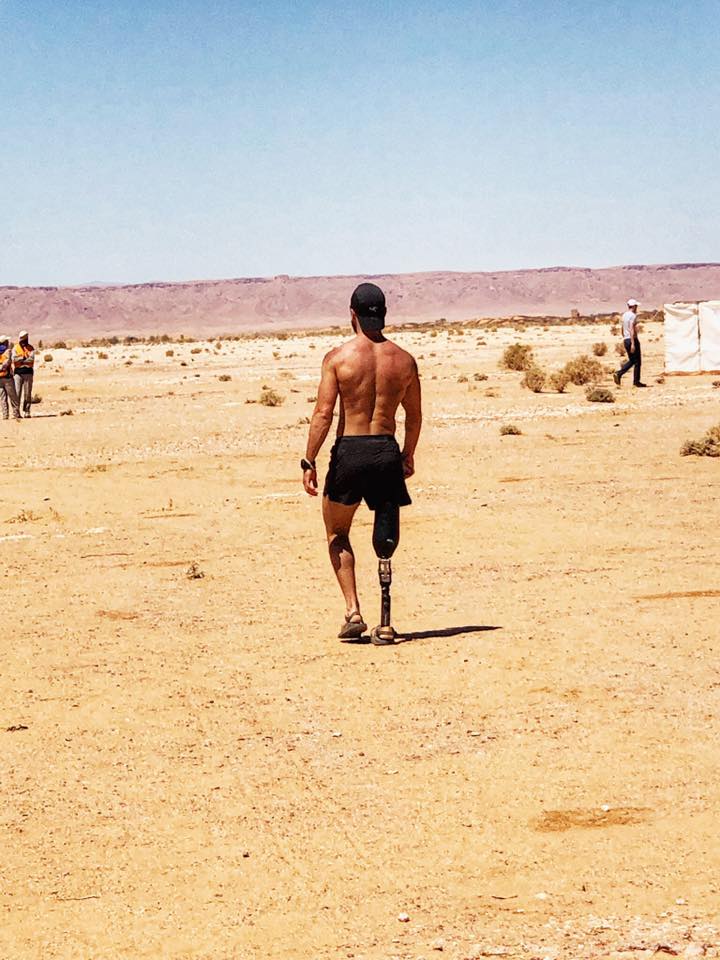
Now you know about the what, the next question will probably be “why,” or even “what the hell?”
Why would anyone want to pay thousands of dollars to put themselves through the inferno of misery and pain that is running an absurd amount of miles in one of the least hospitable places on planet Earth?
Well if you have to ask, you will probably never know.
It takes a very unique kind of personality to want to do this and to actually go through with it and run the Marathon des Sables.
I met a lot of people there, a big chunk were former drug addicts who had survived addiction, there were a minority of heroic amputees, self-made CEOs of successful companies and this was not the first rodeo for many; I met people who had climbed the World’s Seven Summits and other outrageously adventurous accomplishments (including other ultras of course).
I also met a group of friends who had noticed they drank too much alcohol, decided to run the MDS a year ago and that they weren’t allowed a drink of booze to touch their lips until they had finished the event!
This is a race that pushes you mentally as much as it pushes you physically (possibly even more with the former). I want to look in the mirror on my deathbed and say “Did I really push myself to my limit to see what I am capable of?”
Talk is cheap, we can all sit and retweet Tony Robbins quotes to get that sweet dopamine hit when those likes come in, but action speaks louder than words in a world that are becoming more and more obsessed with talking as opposed to doing.
Marathon des Sables is humbling and getting back up off your arse or knees every time you fall is character-building for life itself.
How Many People Participate in The MDS Every Year?
It’s usually around 1000 and I think it’s incrementally growing. With cancellations and all the rest, I think ours was just over 900 participants.
The event has limited space and can sell out, so don’t drag your feet if you’re serious about running the Sahara; get it booked and get prepared.
What Is The Weather Like During The Marathon des Sables?
It may not come as a massive shock, but it’s incredibly hot. A dry kind of heat, unlike humid tropical climates that you may have experienced, but still so bloody hot and uncomfortable with temperatures peaking at 120°F / 50°C in the afternoon.
This is why every stage starts early in the morning, you may think you can beat that midday heat and run a little faster but you have to consider how sustainable that is (something that I found out the hard way).
The best you can do is to cover yourself properly, with the list provided in this guide, put one foot in front of another and get to the end in your own time (unless you are an elite of course or a seriously strong athlete who has done things like this before).
Sandstorms happen occasionally too. You will have the right protective gear for this and the night times can get very chilly, with the temperature dropping into the minuses when the sun goes down (with a biting wind chill), but don’t worry; this guide contains the correct equipment to combat that.
Marathon des Sables Deaths
When I ran it in 2019, there had been 2 deaths in the whole of Marathon des Sables history and yes, there was that one famous Italian guy (Mauro Prosperi) immortalised on Netflix who came a bit too close for comfort and survived by drinking his urine and bat blood, after getting lost in a sandstorm.
He also came back the year after and completed it; what a legend!
Sadly, in this year’s first event since the Covid-19 pandemic hit, an unnamed Frenchman passed away, bringing the total Marathon des Sable’s death rate to a total of three since its inception.
What is The Dropout Rate for Marathon des Sables?
The dropout rate for Marathon des Sables is usually around 10%. 2021 was a massive anomaly, with around 50% of participants dropping out and unable to finish MDS.
This was completely unprecedented, with the weather being even more brutal than usual. Fewer winds made the arid desert more humid and hostile and I have good sources from the event that said there was some sort of freak stomach bug going around, with people projectile vomiting and a much higher demand for IV treatment for even the fittest and strongest people there.
Wildlife in The Sahara: What Creepy Crawlies Live in The MDS?
I saw some pretty menacing-looking scorpions, a few lizards and on the day of the double marathon a couple of terrifying snakes. The scariest of all creatures was a camel spider that made its way into our tent.
Now I am not arachnophobic myself, but let’s be real; Google it and tell me if you’d be perfectly fine with that climbing over your head.
Three of us did a catch-and-release job, however, a local guy freaked out when he saw it and killed it with a desert stone. I’m guessing there is much more wildlife in the Sahara than these 3 scary species, but I’m more than happy to remain in blissful ignorance.
How Fit Do You Have To Be To Run The Marathon des Sables?

A quantifiable (at least by MDS standards) fitness check is to get an ECG with a doctor signing off on it, confirming that you are heart is ready for the trauma you’re about to put it through.
If you have a decent level of fitness and think you could finish a normal marathon without stopping running at any point, then you might be fit enough to complete the Marathon des Sables.
I’m a little ashamed to admit that I was skinny-fat when I ran the Marathon des Sables. I initially agreed to do it during a solid 2-year, non-stop trip throughout The Middle East and Asia and although I was pretty active; I climbed the tallest mountain in Europe and ran a half marathon in Newcastle, I wasn’t in the best shape that I wanted to be for this event after little sleep and way too many sips of local booze on the road.
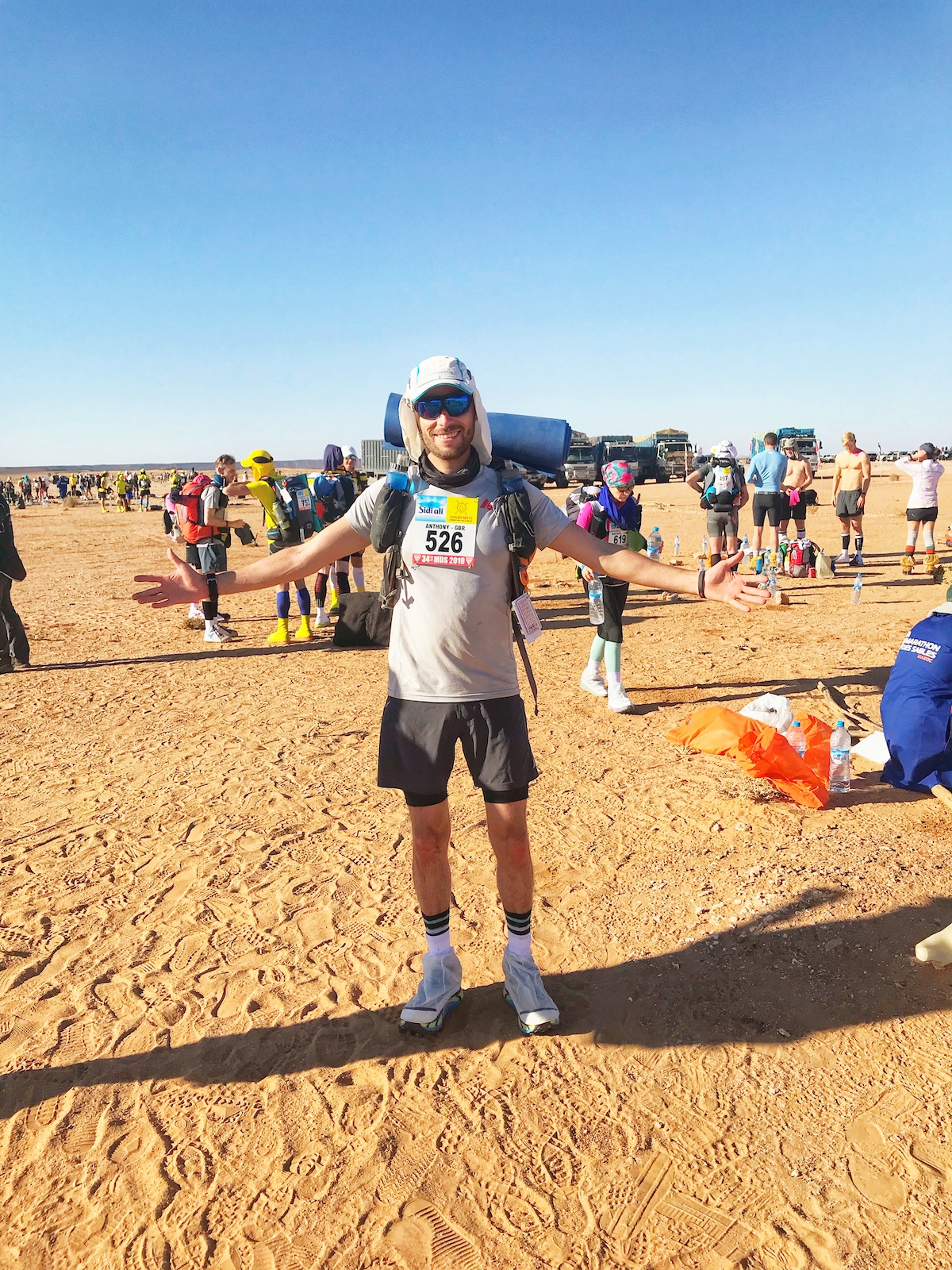
The first full marathon that I ever ran in my life was actually day 1 of Marathon des Sables!
I did take running training seriously and vividly recall being chased by a gang of wild street monkeys while running a 20km one night run during my 2 weeks in Sri Lanka, but long-term travel with a subpar diet and little to no sleep was not optimal for Marathon des Sables training.
However, the experiences on the aforementioned Mount Elbrus and other mountain challenges showed me that most of this type of thing really is in your head. I know that can sound a little cliche, but it really is true; turn up as fit as you can be with the time that you have, but show up with a mentally strong, war-ready mind and you’ll have a much better chance of surviving.
Training For The Marathon des Sables
For at least 6 months, try and get up to running over 100 miles per week so that you are conditioning your legs to run further. If you aren’t an elite or serious ultrarunner, and you just want the glory of finishing the Marathon des Sables, then pay no attention to time and pace, at least in the first few months; just get serious miles clocked up on those legs!
Start off with 30-40 per week and incrementally work your way up, then when you get to 120 miles, start to work on a periodization plan. Oh and lift weights too! I did not do these two things for MDS, but a few years later on, I ran 200kms in one weekend in Thailand and those 2 changes made my body much more prepared for the long distances.
I know this sounds pretty intense and to be honest, it is. You will have to make training your priority and make it a lifestyle. I did the best that I could with the environment that I had, looking back I wished that I halted my travels and focused fully on MDS training, but the experience itself was gold and I am always going to be happy with my memory of the event.
Also (and this is vital), order and wear ALL of your gear from day one.
Might you look like the local twat?
Quite possibly, but you will also know how to tie your bag correctly so it doesn’t bother you, you will get used to the gear you will be wearing on the big day, and you should also be aware of where you typically get blisters on your feet so that you can prevent that on race day.
Again, do not wait until race day to try on your gear. The Marathon des Sables is already hard, there are no extra medals given out to those who unnecessarily make it harder on themselves. Get your gear early as possible, wear it and run like a proud full-kit wanker around your town.
If anyone laughs at you, don’t take it to heart unless you’re going to use it as fire to get you over those intimidating sand dunes.
Get headstrong, and have a big enough reason “why.”
Meditate daily.
Whenever you get time during the day, fantasise (even for seconds) about getting over that final finish line and telling your proud loved ones later on about your victorious battle of Marathon des Sables.
Read and listen to David Goggins. He may not be your cup of tea as he’s pretty direct and swears a lot, but he’s perfect for real talk and motivation for this type of event (should you have a similar mindset).
If you are a bit of a beast and are gunning for a specific time, then check out this post on how long does it take to run 100 miles, just remember to add the reality of sand dunes and heat to this guide!
Does The Marathon Des Sables Really Expect You To Be Self-Sufficient In The Sahara Desert?
If they expected us to be 100%, literally self-sufficient, I’m pretty sure we would all be dead (with the exception of any SAS freaks of nature).
The company provide you with 2 x 1.5-litre bottles of water at every checkpoint, which is roughly every 10 km. There is also a team of locals who set up the bivouac camp and out of respect for the desert, the MDS provide concert-like portaloos and they tidy up any trash (anyone found littering will lose time off their overall score).
Still, this level of sufficiency is a mighty task and successfully navigating through the Sahara and completing the MDS under these terms is nothing to be sniffed at.
The participants are expected to bring (and carry on their backs) a minimum of food totalling a minimum of 2000 calories and a compulsory kit of mandatory items.
To avoid repetition in this article, I will highlight these items in the packing list section. In short, you are responsible for your sleeping gear, basic medical equipment, food and an ECG certificate, signed by a medical professional.
How Do You Eat and Drink During The Marathon Des Sables?

The company provides a packed meal for your coach trip (8 hours both ways) and there is food provided the night before, with mountains of pasta. If you have strict dietary requirements, I suggest you take control of this and take extras with you (I did this, but wish I took a little bit more for the coach ride).
Also, the hotel for the MDS buffet is paid for, courtesy of Marathon des Sables, if you get the pricier package. I am a fan of this option, no one wants to pay more money, but you will be thankful when you’re exhausted and can sink into a lovely, big bed after a shower.
During Marathon des Sables, you will be eating whatever you bring. That’s all on you! Most people, myself included brought zip-loc dehydrated food.
In the morning I had granola with protein powder and water. Very chalky and not appetising, but I find it hard to eat first thing in the morning on the best of days and with us running early (8 am), the fast-ingesting carbs, along with the protein to help repair the previous damage done turned out to be a good choice to get going once that intimidating race gun went off.
Upon returning to my bivouac, I would warm up my 1000-calorie dry-packed meal (cus-cus with other legumes) with my travel oven. Every time was a struggle to get it down, you’d think your body would be craving food after running yet another marathon, but it does some weird things when it’s under this much stress.
A nice little camaraderie tip; leave your stove burning or offer spare hot water to your teammates. This will do wonders for individual and team spirit.
Interestingly, the people that I learnt this from were the two Moroccan brothers who were favourites to win the whole thing (they came 1st and second). Absolute gems of lads, I couldn’t believe it when the champ came over to me and topped up my coffee mug with his left-over hot water, before gently tapping the back of my head, saying “good job, my friend,” with a warm smile.
During the race, you should top up with snacks. Fast ingesting carbs is what it’s all about, I took loads of Clif Bars and had dates (without the seed) at a grab in my right-hand pouch near my shoulder.
Water is provided for you at each checkpoint. You should treat your food the same way you treat your kit and use (eat) it as early as possible during your training, as it’s important to find out what your body responds positively and negatively to.
For me, the sugary gels wreak havoc on my digestion and dates turned out to be much better for me. You as an individual should work out what’s best for you.
If I were to run the Marathon des Sables again, I would only eat ‘Huel.’ It is powdered complete nutrition from the UK and it would be lighter to bring along and much more convenient to make when you’re exhausted.
I met people who brought Huel, attesting how easy it made things and I was furious with myself as I am no stranger to this product and bring it along on every mountain expedition.
What Is The Sleeping Arrangement of The Marathon des Sables?

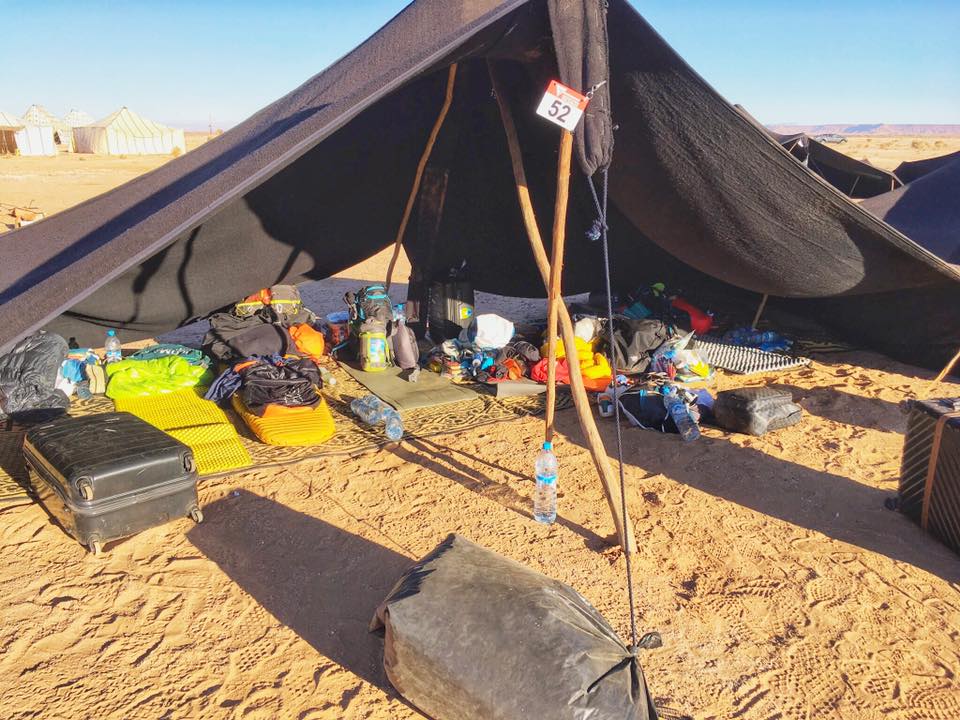
The local guys who descend from nomadic tribes of the desert, do a fine job of setting up a bivouac (a temporary camp) just in time for your tired and weary body that has just stumbled over the latest Marathon des Sables finish line, to live to fight yet another day.
It’s essentially a woollen sheet, held up by sturdy bits of tree bark.
You need to bring a sleeping bag that is both warm enough for the night and light enough to carry on your back every day. A sleeping mat is a good idea too as the ground is cold and bumpy and an inflatable pillow is a godsend without taking up too much room.
You will sleep under the stars of the Sahara Desert, so it’s not just about the ego lift of running the “toughest footrace on earth,” but the beauty of the clear skies in one of the most isolated places in the world. A true gift for someone who is used to living in a relatively smoggy city.
Packing List For Marathon Des Sables
The first rule of the packing list for Marathon des Sables is don’t leave things until the last minute. The second rule of the packing list for Marathon des Sables is to train with all your gear on and try out all the foods, gels and tablets you plan to take on your race through The Sahara.
The third rule is to practice packing and unpacking your gear from your bag so much that it becomes second nature.
Speaking of rules, let’s get the Marathon des Sables packing list started with the mandatory items, those being things you absolutely must have as they are compulsory by the company who organises the race:
Mandatory Items For Marathon des Sables
This is not your typical camping list, you must be tactical with your packing.
Take these or risk being disqualified or punished by added time to your final time. Oh, and the rules state that your bag must weigh between 6.5 and 15 kilograms. (They check this amongst mandatory items upon registration).
- Dehydrated Food that equates to at least 2000 calories per day
- Ultra Backpack
- Sleeping Bag (warm enough for the night, but light enough to carry a sleeping liner helps a lot)
- Head torch with spare batteries
- A whistle
- 10 safety pins
- Anti-venom pump (for snake bites, gulp!)
- Lighter
- Aluminium survival sheet
- Disinfectant
- Tub of high-factor sunscreen
- 200 euros in cash
- Passport
- ECG certificate
- Medical certificate proving you are good to go
Clothes For MDS
If you don’t need it; don’t bring it…
- Running hat
- Buff (baldies should double buff, trust me. I’m well-versed)
- 2 pairs of shorts
- 2 pairs of running t-shirts (get those built for dry heat)
- Ultra Shoes. (Try them out first!) Bog standard running shoes and all-purpose sneakers will not suffice!
- Cheap-assed hotel slippers (They take up less room. You need these to walk/hobble around camp)
- 2 pairs of ultra socks
- 1 pair of gloves (yes, hands burn in the roasting sun too)
- Gaiters (then get an online cobbler to stitch them into your ultra trainers ASAP!)
- 1 Wind-chill coat (they are tiny and compact and block the cold winds during the night)
- Patagonia warm-down jacket (mine was synthetic)
- Sports glasses (I wanted the cool-looking Mad Max type, but left it until too late)
- Open-ended suitcase (for before and after the race, gets taken off you the day before 1st race)
Bedding Packing list For MDS
The sleeping bag is already on the mandatory list, these following things you need to get the best chance of sleep possible to get ready for the next day…
- Compression tights
- Base layer t-shirt and bottoms
- Sleeping mat
- Inflatable pillow
- Sleeping masks (the type that wraps around your head as opposed to the annoying ones that cut into your ears are brilliant)
- Mattress
- Toothpaste (small tub)
- Travel toothbrush
Food For MDS
The most trying for me out of all the list. The energy needed to get me through Marathon des Sables. I’m sure I am not alone in this one. Again, experiment with food as early as possible to know how your body reacts.
- 1 meal for the morning (Mine was granola and protein powder. Minging, but effective)
- 1 meal for post-race (Mine was 1000 calories and I don’t think I have been able to stomach couscous since the event)
- Snack bars (I had 6 Tribe bars/Clif bars for each day)
- Gels (I opted for 10 pitted dates per marathon and Clif Bloks as gels mess with me)
- Electrolyte powders for before during and after each run (I highly recommended the company PrecisionHydration.com for personalised electrolyte powder, depending on the answers you give in their algorithm-based questionnaire, they will send you customised electrolytes tailor-made, especially for you).
- Bag of nuts and seeds (some cheeky healthy fats and zinc for the night)
- Collapsible mug
- Collapsible bowl
- Stove
- Spork (All hail the almighty!)
Tech for MDS
Pretty much all of this is optional. I went very minimalistic and didn’t even pay to use the internet, I wanted my head in the game and nowhere else (plus, you receive printed-out emails from loved ones on the 3rd and 4th day and it’s like an uplifting, old-fashioned letter).
- GoPro (for the memories)
- Basic watch (I used a £5 digital watch from Argos. I left with it when I first left home almost a decade before. The sentimentality value of that…priceless
- Solar Panel Charger (Some like to listen to music, I wanted to breathe in every moment of MDS. But still needed this for my GoPro)
Miscellaneous Items for MDS
You may have already thought about these, or not. However, they are worth a mention
- Imodium. (Loperamide, sold under the brand name Imodium. It’s so good that I wrote a little poem about its brilliance).
- Zinc oxide tape (my mate Eamon learned to tape up his feet for the whole thing. I wish I did, this is the number one thing I would do if I did it again)
- Iodine
- Needle (to pop those nasty blisters)
- Wet wipes
- Moon/Diva cups (I felt so sorry for the women at MDS having this extra logistical issue to worry about. Some women swore by these)
- Sewing kit
- Pain killers
- Anti-inflammatory pills
- Vaseline (for lips, nips and arse crack (I did say this was an honest guide). However, I have since discovered Squirrel Nut Butter, which is superior and you should buy this if you can get access to it.
- Poles? The hardcore calls them “cheat sticks.” I chose not to take them, they do make it a lot easier. I don’t think it is cheating, this was just my personal choice as I wasn’t sure if bringing them would stress me out. If I was to run MDS again, I would take them.
Marathon des Sables in The Media: (Best Documentaries About MDS)
I thoroughly enjoyed these documentaries about The Marathon des Sables…
- Toughest Race on Earth with James Cracknell – Double Olympic Gold Medalist James Cracknell pushes his body to an extreme level in pursuit of an MDS top 50 places.
- Running for Good, The Fiona Oakes Documentary – An inspiring story of Fiona Oakes, the record-breaking vegan marathon runner, who runs an animal sanctuary during the day, tearing up the streets of Asheldham by night.
- Episode 5 of ‘Losers’ on Netflix – The jaw-dropping story of Mauro Prosperi, the Italian athlete who got lost for nine days in a sandstorm during the MDS and almost died.
How Well Organised is The MDS?
2021 was the year of the long-awaited return of the event due to the pandemic. There was an abnormal level of people (over half) who did not finish the event, due to an even hotter climate than usual and a stomach bug, which resulted in people projectile vomiting, fainting, needing IV treatment and incredibly fit runners tapping out due to illness.
I have seen the company come under quite a lot of scrutiny and criticism online regarding their poor handling of the situation, citing a lack of welfare for the participants as the main reason for the condemnation.
I can only go off what I know and experienced and I left the Marathon des Sables incredibly impressed by how much of a well-oiled machine it was. This is not a sponsored guide and I am in no way affiliated with the company, I paid every penny from my own pocket.
The only slight annoyance I had was a famous MDS photographer was a bit of a knob to me and we had a slight run-in. But looking back, that was just a couple of guys proverbially dick-swinging at each other and now I feel almost embarrassed to have been wound up so much at the time.
I’d be interested to see other anecdotes from Marathon des Sables participants over the years.
Marathon des Sables: My Experience Running The “Toughest Footrace On Earth”
Looking for an honest and open Marathon Des Sables review?
Look no further than here. If you’re wondering what the “toughest footrace on earth” truly does to your mind, body and spirit, then I promise that this is a no-holds-barred account of what went down during my completion of running 6 marathons in 6 days in the harsh, unforgiving environment of The Sahara Desert.
As the turn of the new year approached in 2019, I decided that this would be the year that I rose like a phoenix from the ashes, but I needed something concrete to work towards. A goal to focus on that would intertwine with the need to be physically fit, but I also wanted to go HARD in terms of a challenge.
The successful slog on Mount Elbrus in freezing Russia showed me that I have the necessary grit in my locker, for when the going gets tough and I am physically drained, however, The Marathon Des Sables seemed like a different kind of beast.
It intimidated the hell out of me and I kind of liked it.
At the end of this post, you will have a good idea of what the week-long itinerary looks like living and running in the largest desert in the world, and how I, as a pretty average bloke in terms of athleticism sweat, bled and cried my way over the finish line to a lifetime of glory…
I’d heard about this crazy race before on the Rich Roll Podcast, and while I don’t believe in ‘signs’ from the ‘universe’, this was exactly the type of thing I needed to sink my teeth into and so I signed up.
I kept up my hectic travel schedule during the remaining months of training, visiting North Korea, China, Nepal, the UK, Azerbaijan and Sri Lanka and I got to a point where I was running pretty much a half-marathon every morning.
I approached a British Marathon des Sables hero on Twitter called Tobias Mews for a paid telephone consultation. He had finished 21st in the event in 2011 as a Top British finisher, and went back in 2013, finishing 15th and 3rd overall Brit.
I had absolutely no delusions of grandeur that I could achieve anything like that, but I figured it would be nice to get some inside info in terms of the right gear and what to expect.
Tobias was an absolute godsend in terms of helping and being a calming presence for me and my packing situation, and Marathon des Sables came around in no time. Before I knew it, I was boarding the plane from London Gatwick to Ouarzazate, Morocco, right in the heart of the desert.
Johnny introduced me to one of our eight potential tent mates, a laid-back Irish lad called Eamonn who I’d been chatting with on Instagram during the training months. We hit it off immediately, fantastic,
Now the mission was to find 6 more legends to make up our dream team tent in the Sahara.
Nervous energy was running high on the plane and, being the chatter that I am, I struck up a conversation with the fella named Paul next to me who had absolutely no say in the matter.
Paul was a Scouser with calm energy, in great shape, a fireman and a doting dad of two lads. I pretty much branded him with my Marathon des Sable’s prod as “one of us” and, as dodgy as it sounds, I unashamedly asked a complete stranger who I’d just met on a plane if he’d like to sleep in my tent with me.
Three down and five more to go.
After we arrived at the airport in Morocco, Johnny told me he’d also found a few guys on the flight. The Marathon des Sables gods were shining down upon us and we couldn’t have hand-picked a better bunch even if we’d tried as we settled in for the six-hour bus ride into the desert wilderness.
Damian, gifted with hilarious dry wit and intelligent conversation, Chris, a buff 6’2”, former Royal Marine with a measured and tough personality, and then the cherry on top of the MDS tent cake, Rocky – who we sometimes affectionately referred to as “Dad” due to his ability to fix any issues and for constantly being in dad mode – one of the most genuine, gentle and fun blokes I’ve ever had the privilege of meeting.
Good vibes bounced off that man and I’m sure it was a big factor in our overall morale.
An Indian guy named Ansar was already in the tent when we arrived; he was quiet, a bit of an introvert, and an absolute champ of a guy.
We had our dream team ready and the nerves surrounding our gear, fear of failure or of receiving a fine for not having the correct kit were alleviated by the natural, positive energy and flowing conversation in our group.
That night, we got into our sleeping bags knowing that the following day was all about registration, after which we would hand in all of our luggage and be left with our tiny running bag to last us a week in the Sahara.
Marathon Des Sables Admin Day

The day went exactly as I had expected it to – full of anxiety, followed by the relief of getting the job done. Everyone was worried about forgetting something and all we wanted to do was to get checked in and signed off with a thumbs-up.
When I registered, I weighed my bag (9 kilos before water), handed in my signed medical certificate and ECG results, and received my salt tablets from the medical staff.
The doctor freaked out a bit when he saw that I’d declared on my form that I am allergic to penicillin, which was a bit odd. It’s important to note here that I’m not criticising the medical team of Marathon des Sables – they were phenomenal and I’m sure it was a stressful job registering 900 people in one day.
The time came when we said goodbye to our extra bags and we were left with only the clothes on our backs and the gear inside our running bags. It felt so real and the next day was the first race day.
Day 1 Of Marathon Des Sables
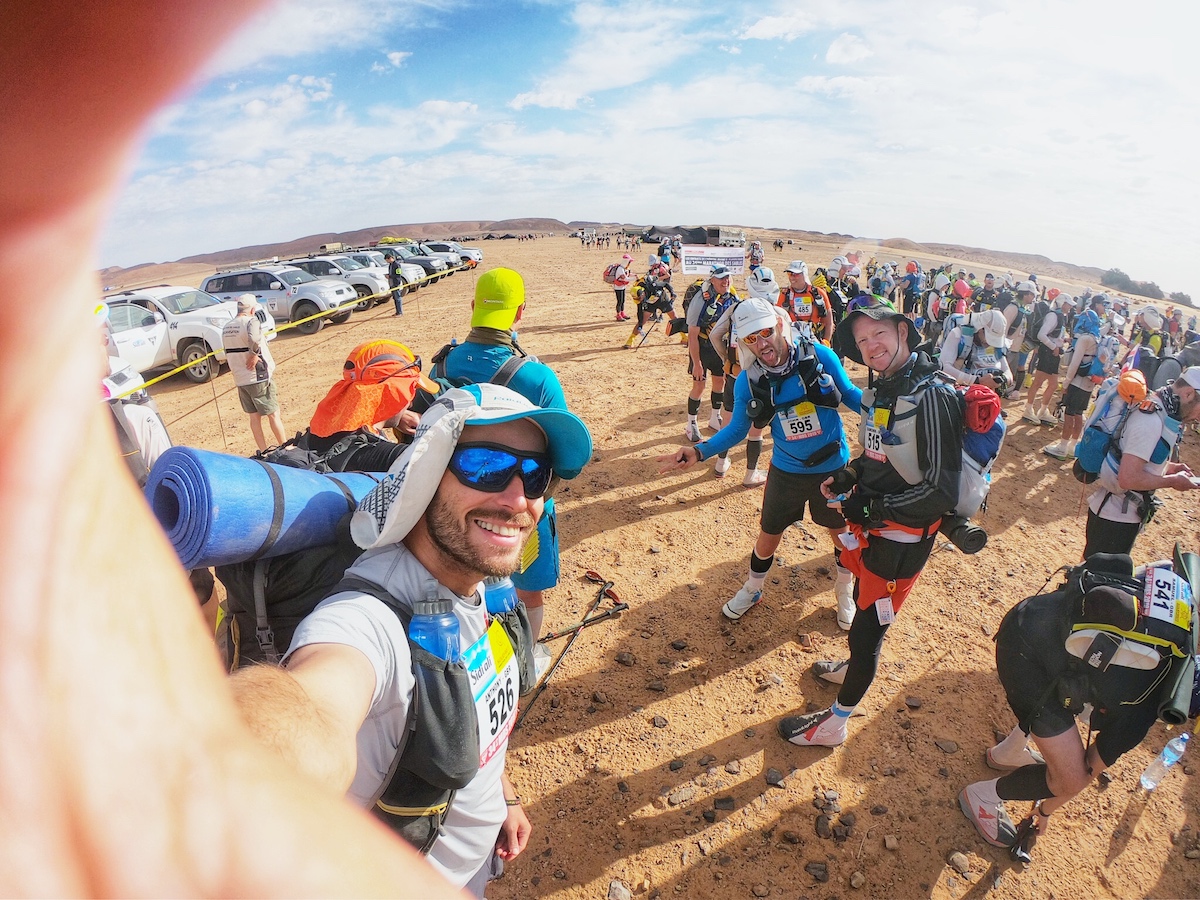
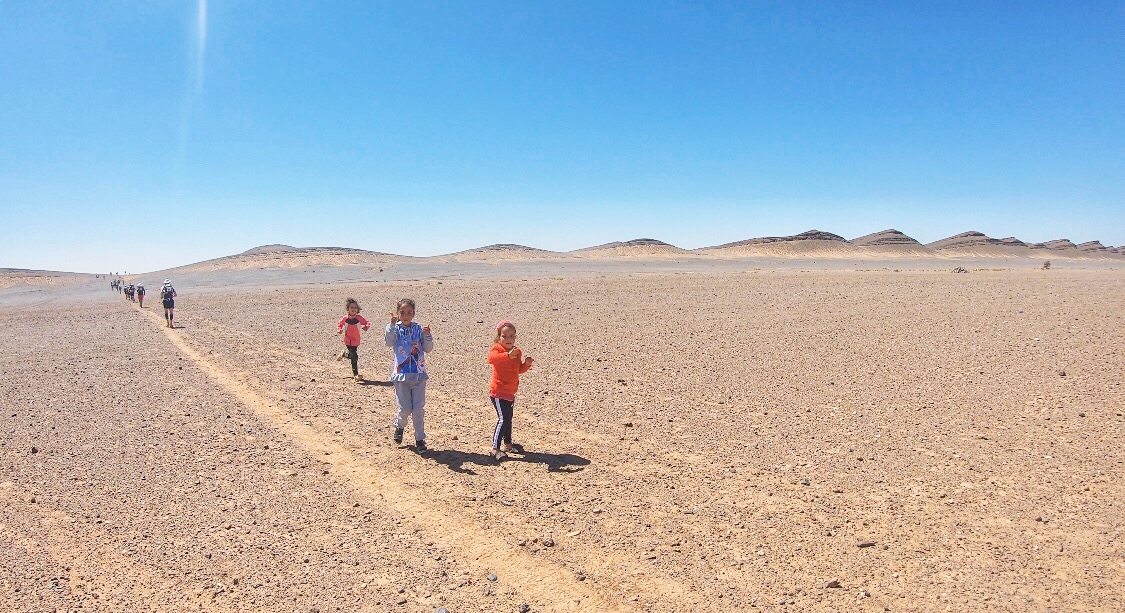
I had an absolutely crappy night’s sleep that night (sadly, a common theme for me at Marathon des Sables) and woke up at 6 am, in time for the 8:30 am race start. I chomped down on my grainy granola/chocolate powdered mix and got myself ready for the race – this was it! We were finally there… Tent 52 was about to lose its Marathon des Sables virginity… well at least for this team of gents, all running the MDS for the first time.
Before the countdown to the race started, a Marathon des Sables tradition was carried out, blasting AC/DC’s “Highway to Hell” from the loudspeakers.
Nice touch. It got the adrenaline pumping.
Then, bang – we were off, 900 of us running off into the Sahara Desert with our battle bags.
This turned out to be my fastest and easiest (not to be confused with “easy”) day; most of the sand was hard and I pounded it, giving it my all. The sweltering heat made it very difficult, but I just got my head down, didn’t chat with anyone and ran about 85% of the race.
It’s not possible to run the whole thing as a mere mortal, as the routes contain soft sand dunes that need to be climbed. I had no hiking sticks, but I felt strong, hydrating and refuelling at every 10 km checkpoint.
Cute local kids ran out from the villages to blow kisses and high-fived us along the way. Life felt good, albeit in a Sahara Desert-struggle kind of way.
I got back to the tent at 04:43:22. I felt proud of my effort but made sure to stay grounded in reality. We were warned that day 2 would be hell; so bad that Marathon des Sables’ organisers reluctantly knocked a few kilometres off the usual total because this day would be so unprecedentedly brutal, with the course bragging a whopping 16 km of the biggest sand dunes in Morocco in a gruelling 34 km race.
I immediately took off my socks and was happy to see I had no blisters. Sweet! Later that night we went to watch the last few people come in over the line. The rule is that if you fall behind a chosen camel (sometimes a Jeep) then you are out of the race.
It was touch and go, and the last remaining person was an 83-year-old man from Corsica. He made it just in time, and we all gathered to give him a rousing round of applause.
He celebrated by simulating a golf shot with his hiking stick at the finish line. What an absolute boss!
Day 2 of Marathon des Sables
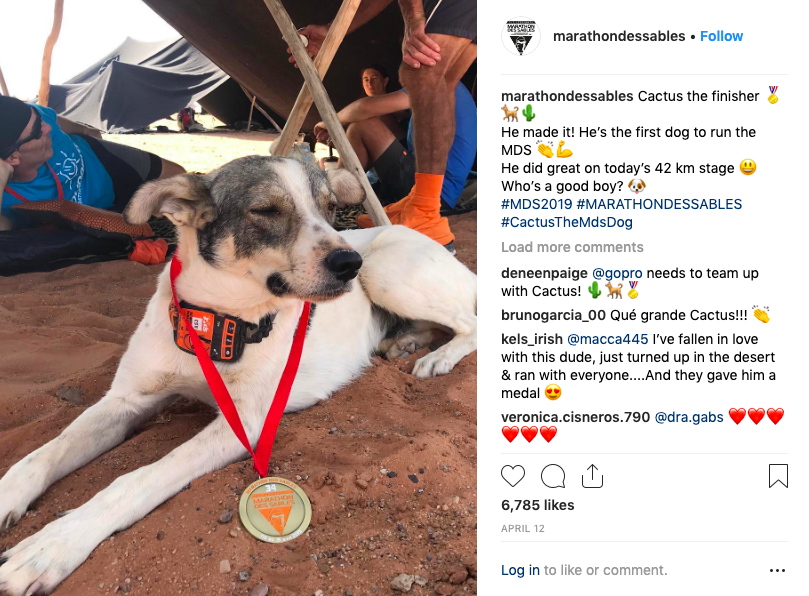
I really want to just write “fuck you, Marathon des Sables” a thousand times for this day, but I don’t think it’d be very helpful.
This was the worst day of Marathon des Sables for me by far.
Climbing massive dunes turned out to be a bit more of a weakness for me than I had anticipated. I clearly put too much emphasis on cardio in my training and not enough on leg power and strength. My skinny little pins were no match for the mammoth dunes which, cruelly, were all soft sand – an absolute nightmare to navigate and get up.
Stupidly, I also didn’t hydrate properly at the stations, impatiently wanting to just get on with it and get the day out of the way. I found myself completely parched for what seemed an eternity before I got to the 3rd checkpoint.
It felt like everyone overtook me (it must have been hundreds, I was so weak and dehydrated), and a big chunk of them asked me if I was ok. I was wobbling about and must have looked very worse for wear.
A guy from Sunderland (a neighbouring city to my birthplace, Durham) checked up on me with a few miles to go and chatting with him helped me forget about my predicament for a fleeting moment. These random acts of kindness and consideration for the welfare of others were commonplace during the daily races of the Marathon des Sables.
A little gift from man’s best friend, ‘Cactus the dog’ who became so viral online that he got his own column in the Independent and Business Insider (to name but a few) helped me out halfway through the race. Other than the occasional lizard, he was the first animal I’d seen that week and does it really get better than a dog to lift the spirits?!
I stumbled back to my tent after 07:25:27. I was so happy to be back. As I was getting my bag ready for the next day I looked across and noticed we were sitting opposite the Moroccans – the professionals who absolutely smash the race by a country mile. The younger brother who usually finishes second to his older brother smiled over and offered us a cup of tea.
I’m very rarely the man to turn down a cuppa, but I politely declined as my feet were a wreck and I needed to get to the medical tent, but the gesture itself warmed my heart and gave me a lift.
In the morning, the main man, Rachid, made an effort to smile at me and put his hand on my shoulder as I passed him. He did the same to others hobbling about. He knew we were hurting, and this tiny gesture spoke volumes about the man.
A champion in more ways than one.
Day 3 Of Marathon Des Sables
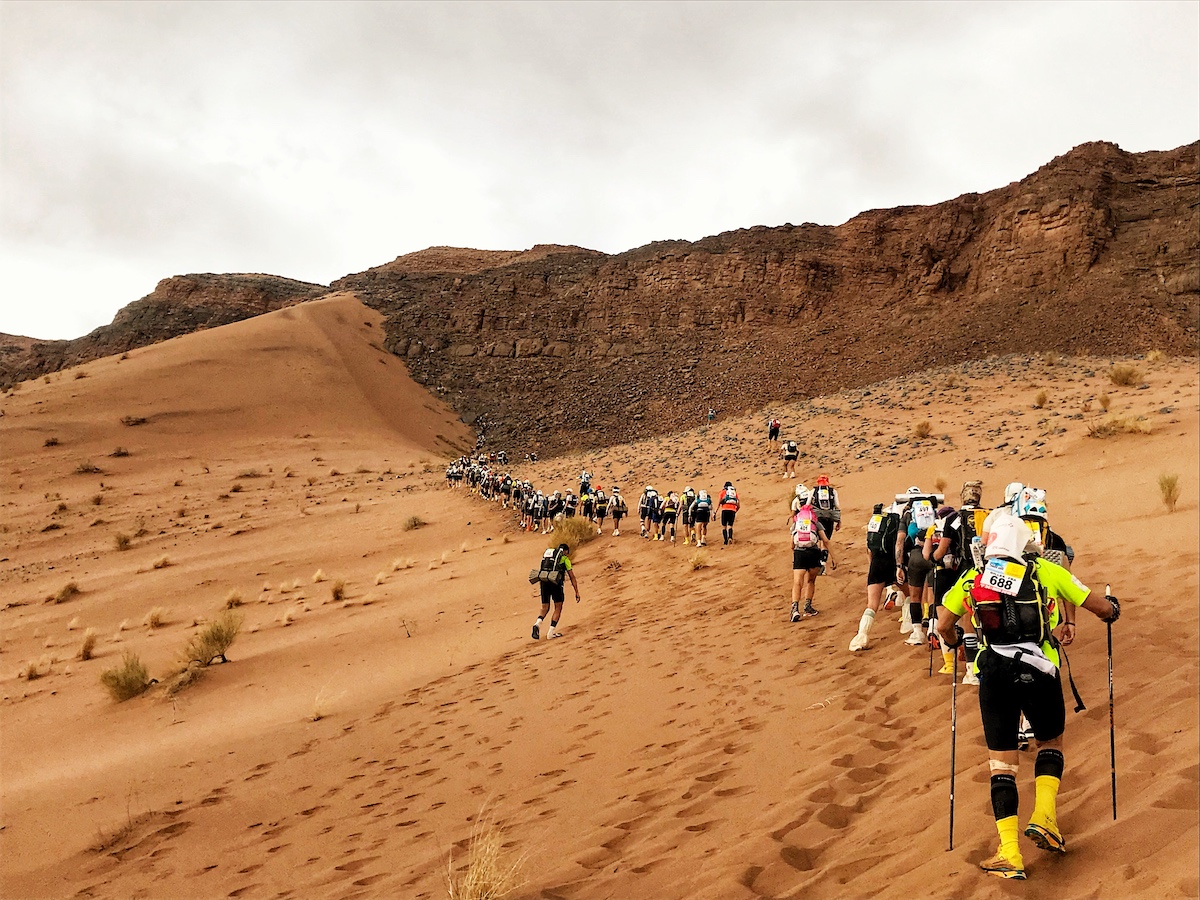
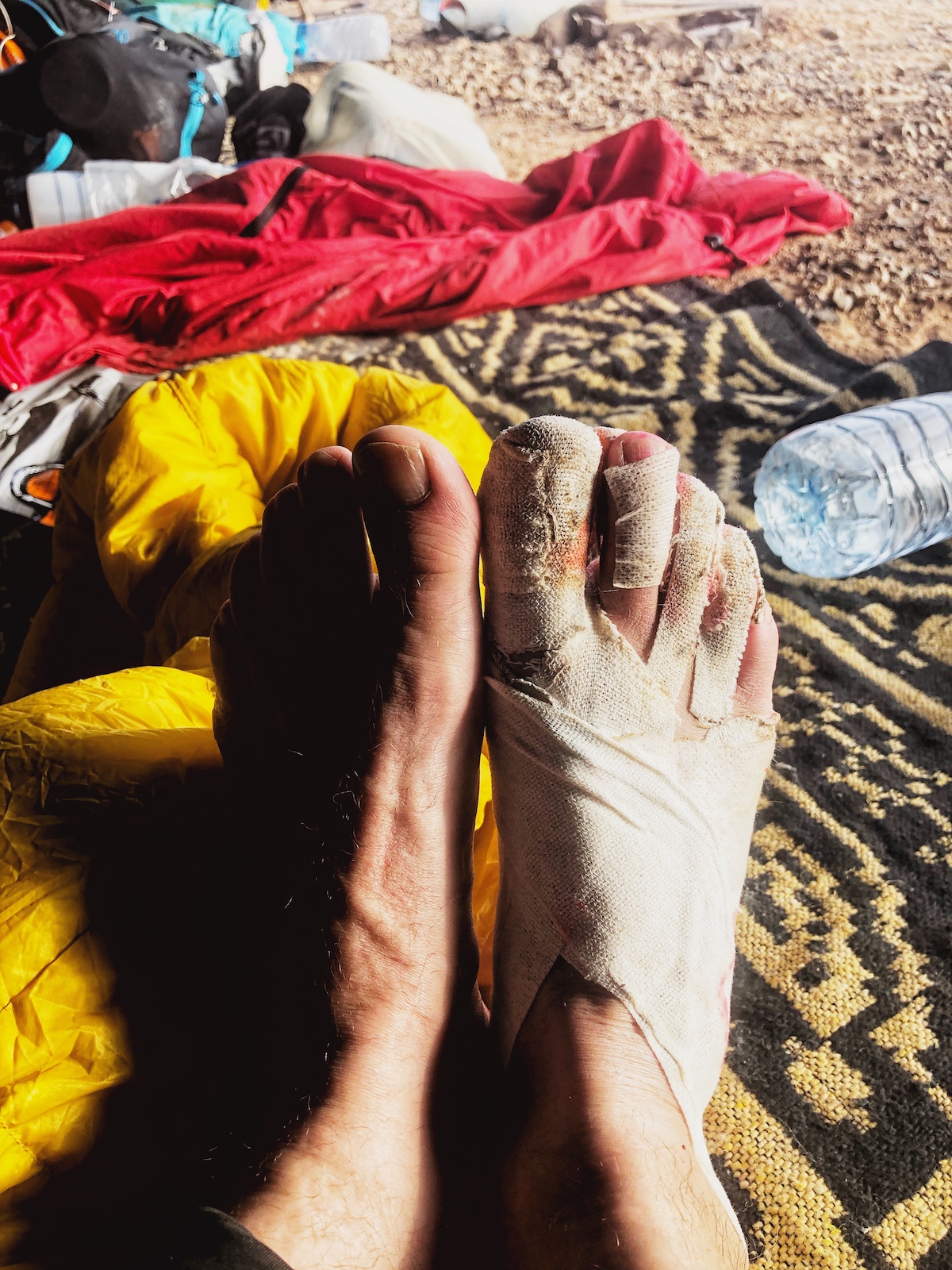
More stupid sand dunes. Not massive ones like on day 2, but sneaky, medium-sized dunes with soft sand. I didn’t make the same mistake as the day before, or for the rest of the race, staying well hydrated at every opportunity.
I was in a bad way though, with blood starting to show through the back of my t-shirt. My bag was rubbing against it, and on top of this, I had horrendous blisters on my toes.
Damian from our tent sacrificed his time to help bandage me up on the sidelines to stop the blood pouring from my back – a real superstar move.
I tried to ignore the pain and cracked on. However, I was overcompensating by putting more pressure on my left foot as my right foot had so many blisters, and 5 km later I sprained my left foot.
It’s hard to feel too sorry for yourself at Marathon des Sables when there are so many disadvantaged heroes just getting on with it. When I was hobbling I saw a lower-leg amputee lady absolutely gun up a big dune.
She blew me away and lifted me up at the same time, her warrior spirit radiating its way into me.

I sucked it up and hobbled over the finish line, a hard 20 km later. Another long day of scrambling through the Sahara Desert at 07:33:39.
(No photos were taken on this day, the priority was getting over the line. I certainly was not in the mood for fake cheery dune selfies on this day).
It’s important to note at this point that every night we received sheets of A4 paper containing emails from our loved ones. I can’t speak for everyone else there, but this really lifted my spirits when I was ever feeling dejected, or worried and it made the world of difference to my mood and resolve – a nice touch from the Marathon des Sables organisers.
I’ve already resolved to email the person who will adopt my race number next year and send daily notes to help them through. Knowing that people out there spared a thought to care about me and were aware that I was still cracking on, really helped me out during some times when my internal self-dialogue wasn’t the most chipper.
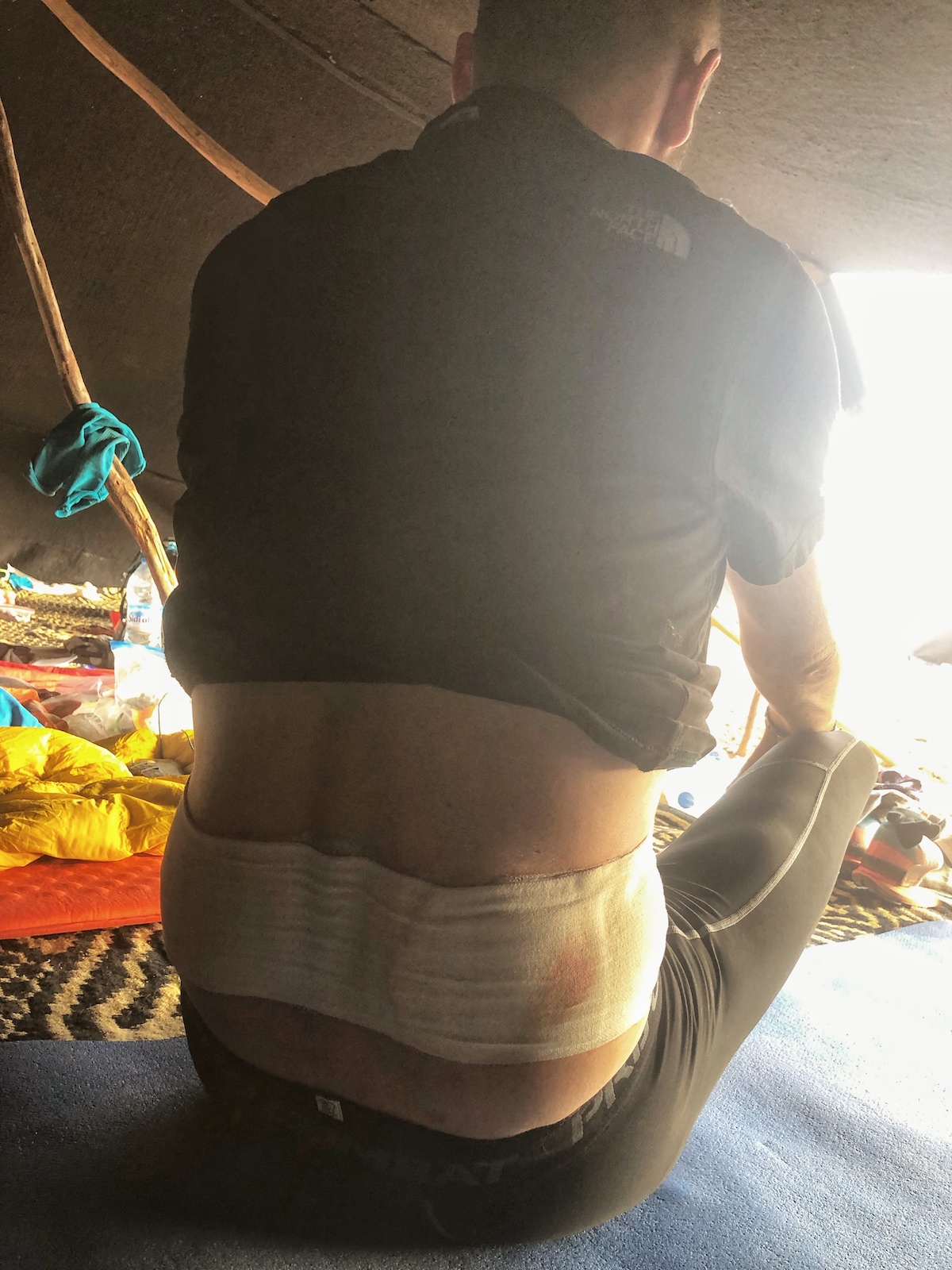
Day 4 Of Marathon Des Sables
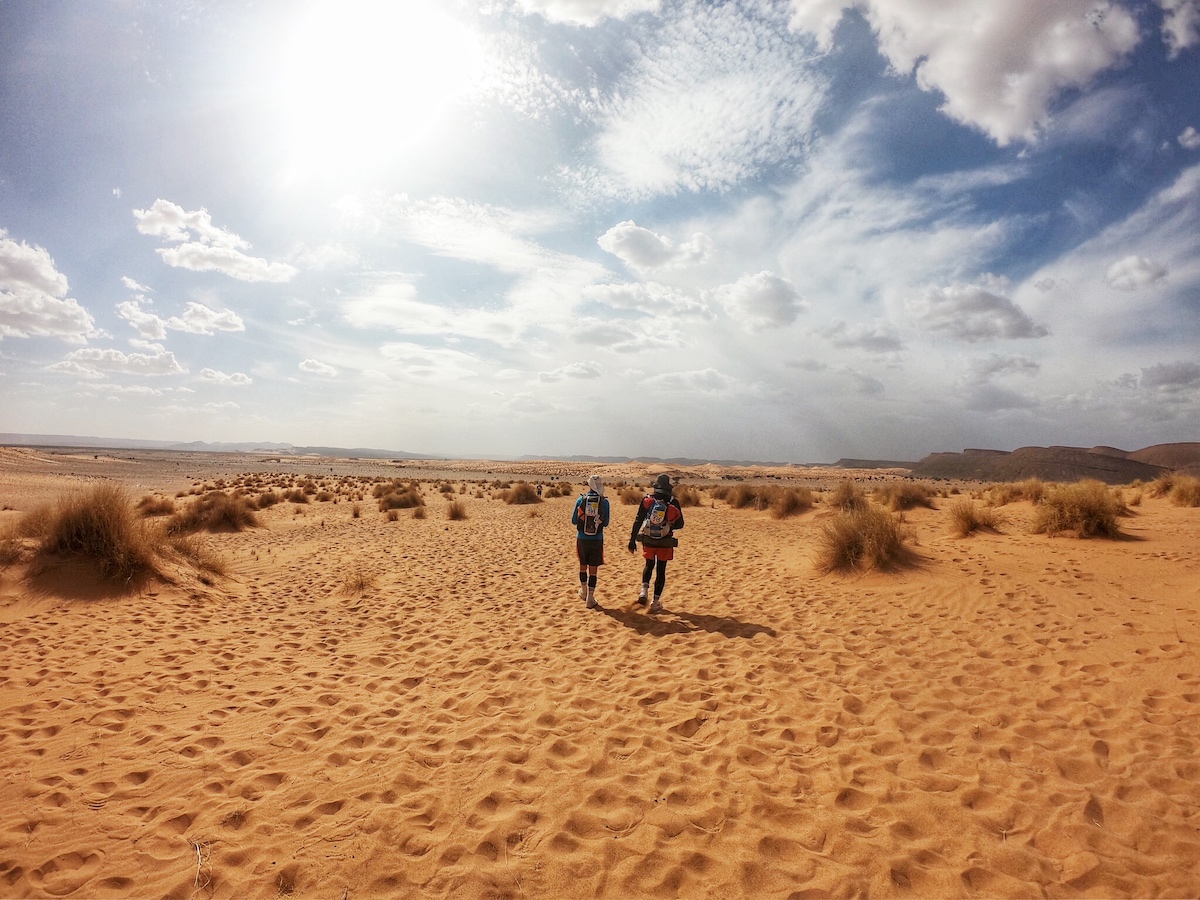
This was the Big Mac, Daddy Day of the week! A whopping 76 km ultramarathon in the Sahara Desert!
To say I was concerned would be an understatement, but the medical team had bandaged me up good and proper and I was able to run a bit more comfortably, supported by the false sense of security that came from a host of painkillers.
This was a day of marching, running and battling sand dunes, which took me just under 17 hours to complete!
The painkillers could only do so much, and I had to just ignore the aches. I started the race with a very slow run to conserve my energy, running with Eamonn for a few hours. He was a really strong runner and it pushed my limits, but I happily covered a lot of ground while keeping up with him.
I was in a lot of discomfort later on and I had an issue with my sleeping bag – it kept falling out of its compartment from my bag and onto the sand.
This might not seem like too much drama to anyone reading this but, trust me, when you constantly have to take off your bag and rearrange your kit when you’re in the middle of a 76 km ultramarathon in the sweltering heat, it becomes physically and mentally exhausting – a daunting task which zaps away your precious energy.
In my opinion, Marathon des Sables is roughly 80% mental and 20% physical. You really have to be positive and shut down any negative internal dialogue, and this was testing me as I was limping on. At this point I also had a new injury and, not meaning to be crass, I had been bleeding out of my arsehole (thanks for asking) for the last few days and it was really painful down in that tender region.
It seemed that Marathon des Sables was trying to break me, but I was not ready to be broken.
Later on, I caught up with Johnny who had a strong march going on. I wasn’t able to run but I figured that if I could keep up with him then I’d be able to get the ultramarathon done sooner rather than later.
7 pm arrived and we had to put our head torches on to navigate through the desert. On this occasion, we opted to eat our high-calorie dinner during the race as opposed to at the end of it when we would just want to crash into ‘bed.’
Hours later, while we were still in the race, I would hallucinate that I saw a curled-up snake below my feet, which made me leap in the air like a cat in a viral internet video. I also imagined that an Arabic man in a tiny red hat was serving tea and offering me it.
I said to Johnny with delight: “they have tea, get in!” He had no idea what the hell I was talking about because, of course, I was talking nonsense. Delirium was hitting and I needed to finish so badly, but we never lay down at any checkpoint – I didn’t trust myself to get back up due to pure exhaustion.
Speaking of delirium, two kilometres from the final checkpoint of the 76 km ultramarathon (the one before the finish line), the sick bastards at Marathon des Sables decided to create a route where we had to climb over not one but two steep mountains.
On the way to checkpoint 5, we bumped into our tent mate, Damian, who was even more delirious than me. Almost incoherent and pale as a sheet, he barely recognised us. We walked him to the checkpoint where he rested before taking on the final 5 km, which must have felt like climbing Mount Everest for him considering the state he was in.
Johnny and I cracked on and made it back around 2 am. We’d been going non-stop since 8 am the day before and we felt it, hobbling in at 16:48:28.
I crashed into my sleeping bag, knowing that I’d be spending a decent amount of time on the rest day in the medical tent. I woke up 2 hours later with a throbbing pain in my IT band, shooting down the side of my right leg.
Marathon des Sables had really done a number on me, but I took a big scalp from it after completing the ultra.
Day 5 Of Marathon Des Sables
Rest day. Time to get fixed up by the amazing French volunteers who sorted us out in the medical tent, rehydrate, refuel and get ready for the final countdown on the following, and final, day.
I was a mess. Sprained left ankle, blisters on top of blisters on my right foot, and a bleeding bum and back, and during the night I also developed sickness and diarrhoea. Sexy!
The camaraderie in the tent was fantastic though and while we all had our own issues to deal with we pulled through because we all gelled so well.
Day 6 (Final Day) Of Marathon Des Sables!
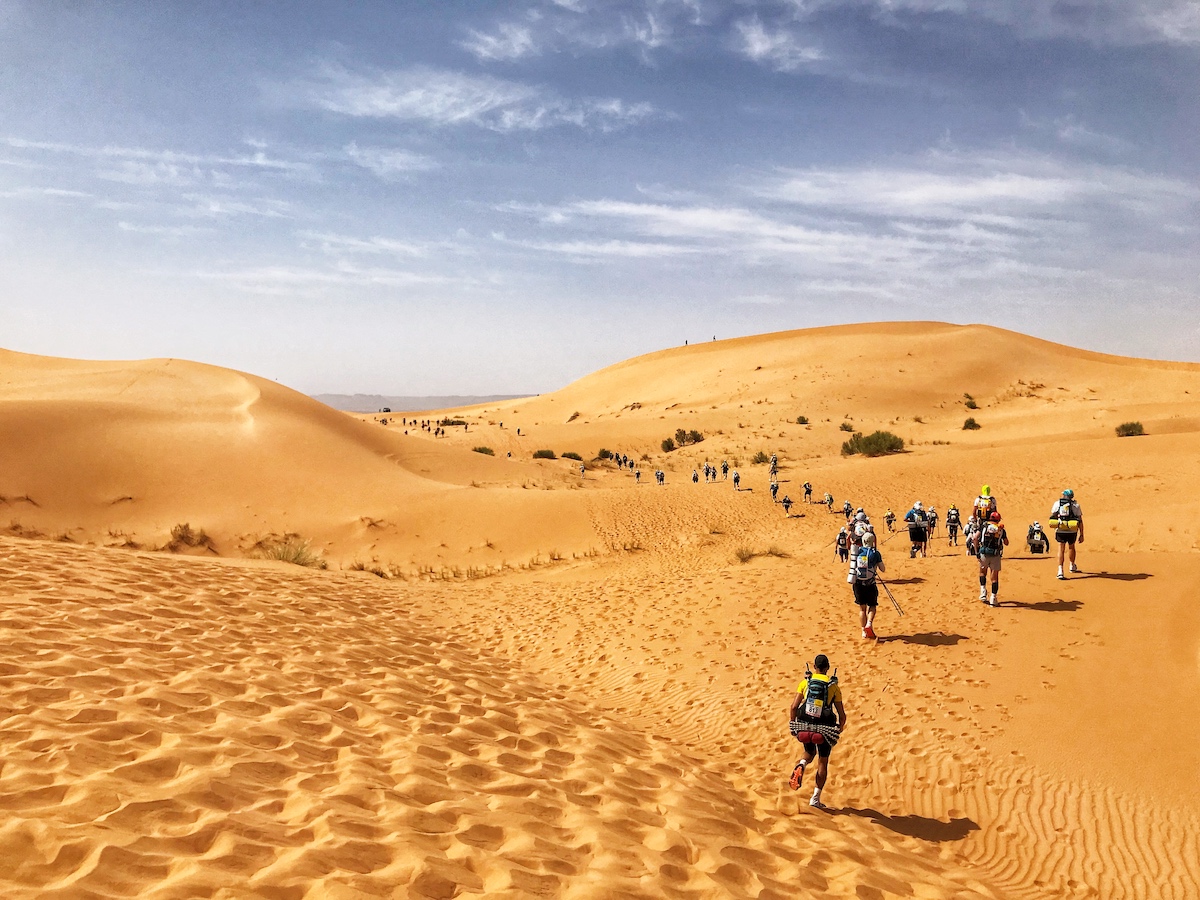
One more race! Just 42 more kilometres to go, starting at 7 am. Time to ignore the pain and get through it. And that’s exactly what we did.
Until I met the dreaded dunes which slowed me down quite a bit.
Johnny started the whole Marathon des Sables injured, and he decided to run the last two legs of the final marathon despite his stress fracture. This inspired me to hurry, to try and scramble to catch up and to dig deep in the dreaded dunes, which actually turned out to be his forte and by far my biggest burden.
For me, the most beautiful part of Marathon des Sables was finishing the race with Johnny, running strong for the final 8 km or so. The finish line was visible for 5 kilometres – the final cackle of evil genius by Marathon des Sables.
A lung-busting effort on the final two kilometres saw us over the line with physical exhaustion and complete emotional elation.
The older I get, the more I want to share experiences with people who are important to me. The Lone Wolf mentality has its positives, but it can sometimes feel hollow. Crossing that final finish line with one of my best mates is something that I’ll never forget. I was so relieved to get that medal around my neck.
My first and final days turned out to be my best performances for the Marathon des Sables, with us getting in at 06:33:56 for the last marathon.
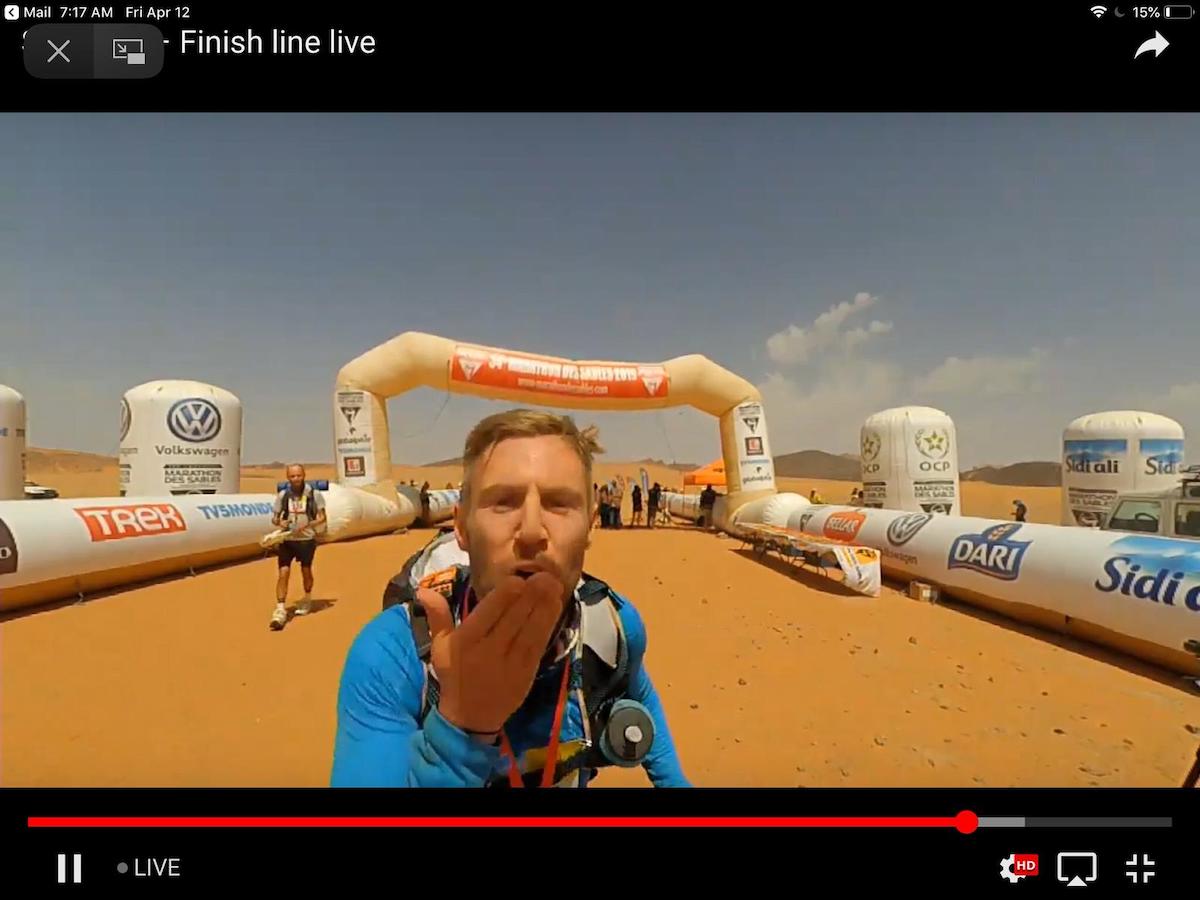
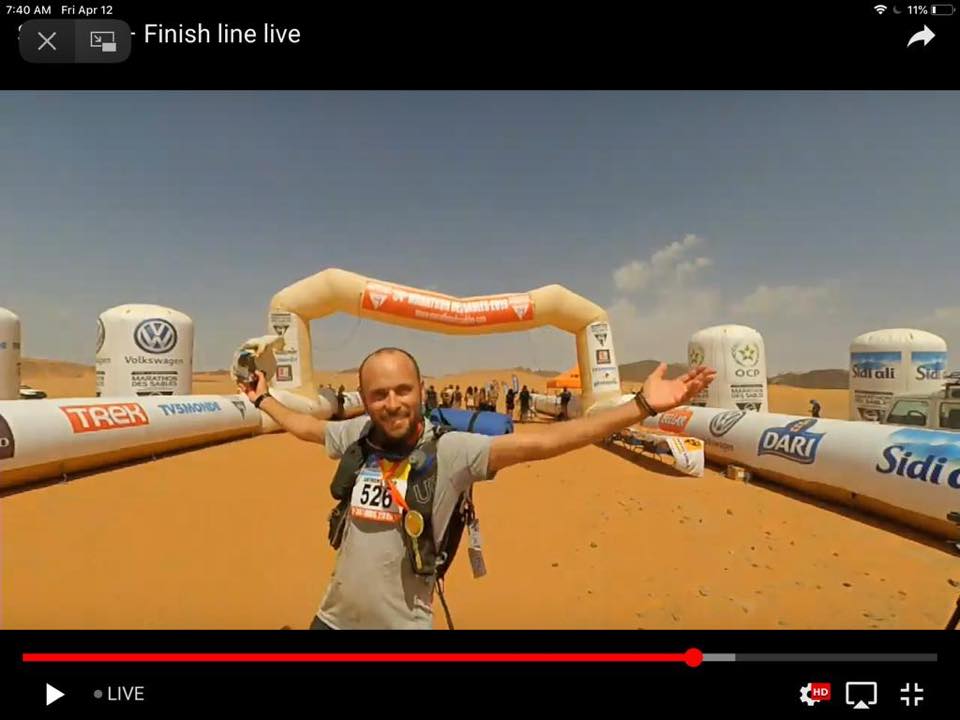
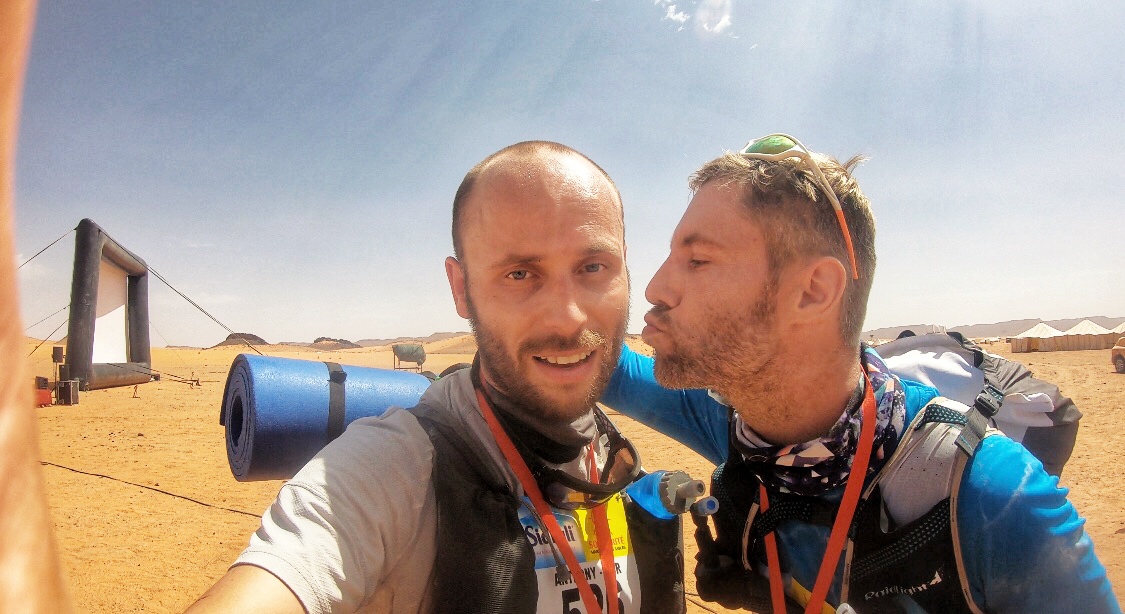
After finishing we continued that beautiful Marathon des Sables tradition of going to cheer and applauding the final finishers.
A middle-aged lady warrior broke down in tears as she crossed the finish line, tears that were pretty infectious to all of us watching.
A Japanese man in his 70s followed her, smiling away and almost collapsing with exhaustion at the end as he clambered over the finish line.
A couple of hours before that, a blind man crossed the line with his guide. What an unbelievable calibre of humans at Marathon des Sables!
The energy that night was euphoric beyond description. The whole of tent 52 survived and the walking wounded back in my second home (the medical tent) felt triumphant. The only thing that ruined the party in our team tent was a massive, creepy, gatecrashing camel spider!
The day after we had to take part in the obligatory 6 km charity run and then we went back to the hotel to celebrate in style!
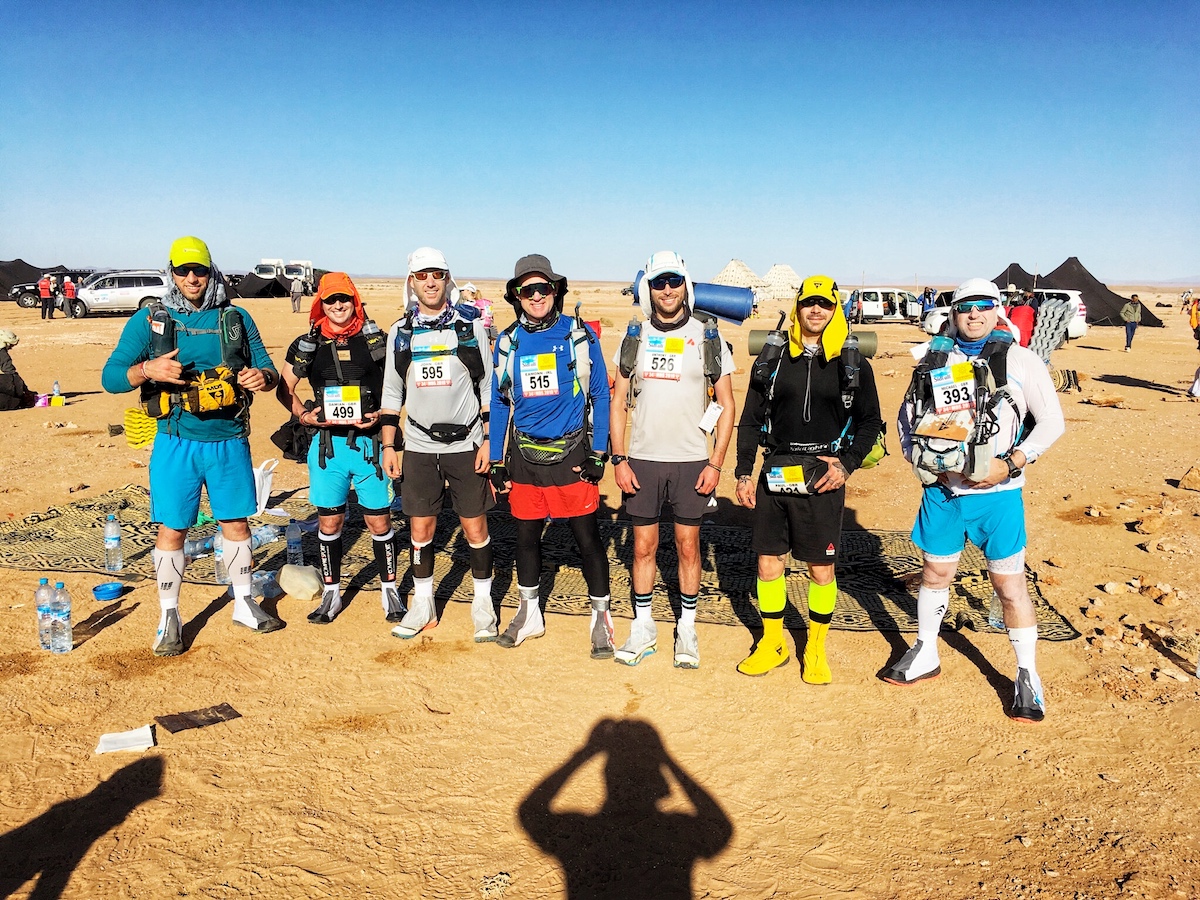
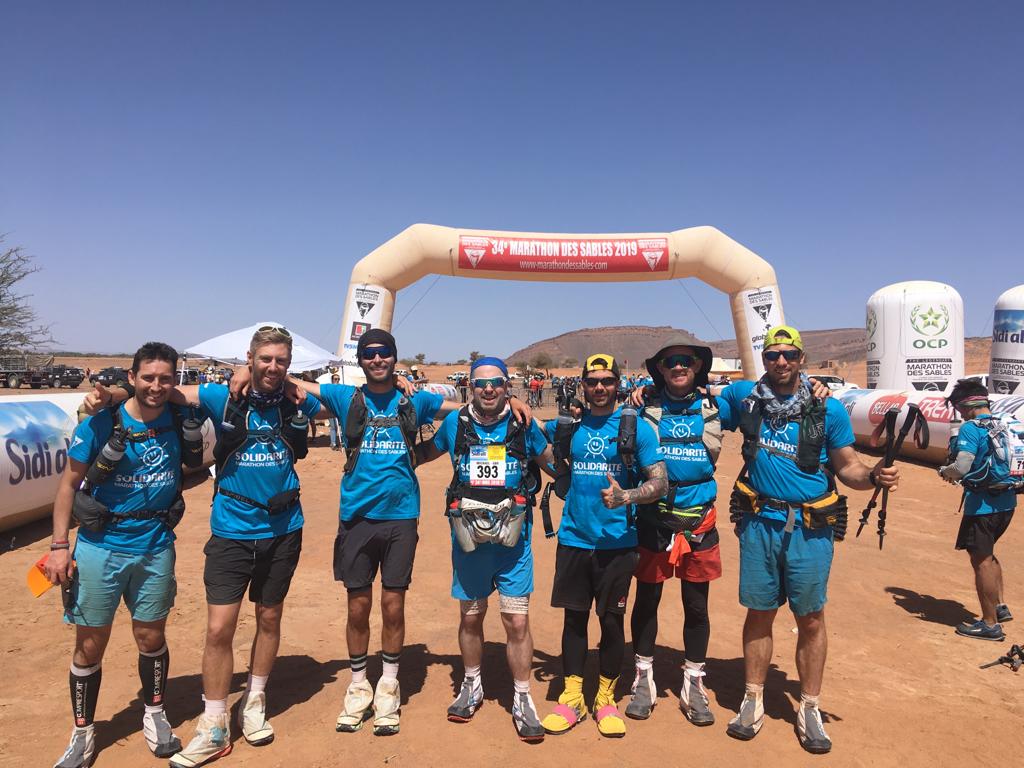
Would I Have Done Anything Differently?
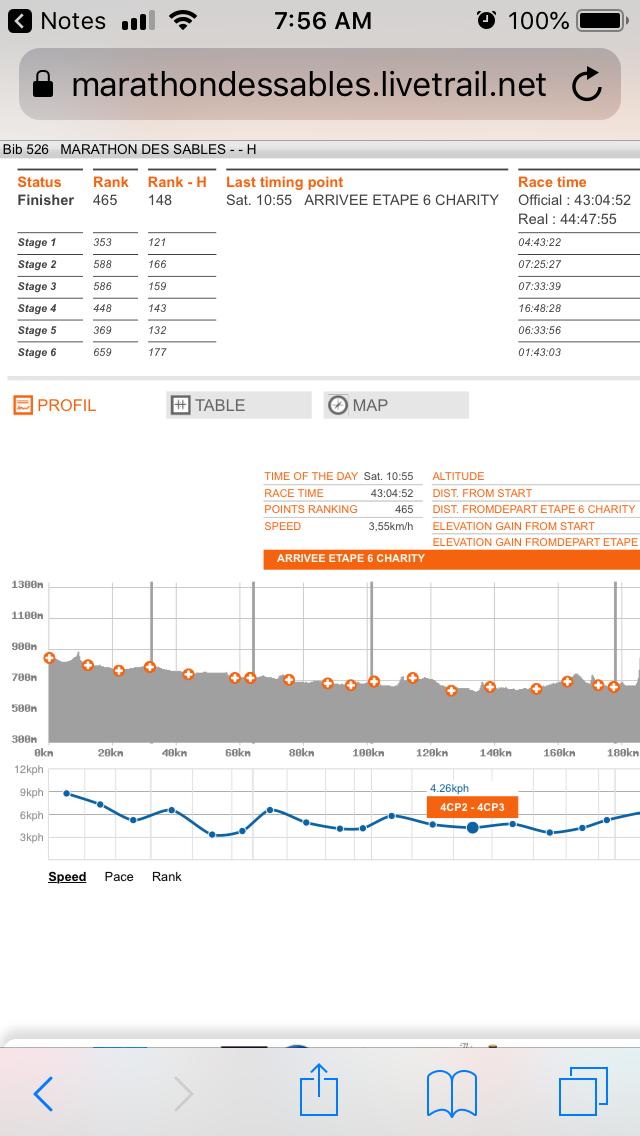
Of course, it was my first time and even with the amazing advice from Tobias, I would still learn things in the process of Marathon des Sables so that I could perfect my performance if I were to do it again.
Spoiler alert: I will not be doing it again (probably, but I did say I would never run over 5k again and I ran 123 miles in one weekend after saying that). I really want to write a book at some point for first-time Marathon des Sables participants. There’s not an awful lot of information online and I think it’ll be a fun book to write.
(Edit: still catching up on the travel guides, so this is a distant dream for now).
What I Took Away From The Marathon Des Sables
Believe me when I say that every penny of the £4,250 and every drop of the blood, sweat and tears was completely worth it.
The spirit of the people at Marathon des Sables is something that I am very grateful to have been around. It was humbling, inspiring and captivating.
It’s so much more than just a couple of hundred mad people running a mad race in the desert. Marathon des Sables asks questions of you, and wants to know who you are and what you’re made of; it challenges you by beating you down to your knees, but its double-edged sword is that it’s designed to lift you up when you find the strength to overcome its challenges.
Other highlights were meeting the utterly brilliant Rob Pope, AKA “The Real Forrest Gump,” pride of Liverpool, who finished 14th place in Marathon des Sables despite having some difficult news about a loved one back home.
Then there was the story of the amazing amputee lady on the final day, hammering it through the sand like she did every day – the top four runners from Morocco stopped mid-race to give her a hug and a kiss on the cheek, affirming her how incredible she was and that she was almost there.
I met so many real-life heroes at that event and, of course, the people with who you share the experience make all the difference.
Looking at the team in our tent was like watching a delicate orchestra, every member in smooth sync, creating an organic and perfect harmony and the happiness was shared out accordingly.
None of us could truly rest at night until every member of tent 52 had arrived back from a race. Johnny and I were saying on the final day just how much we wished we could bottle up the good vibe and emotions that we felt on that final day; it’s not possible of course, but I’m going to simply continue pushing myself and my limits and live for those moments.
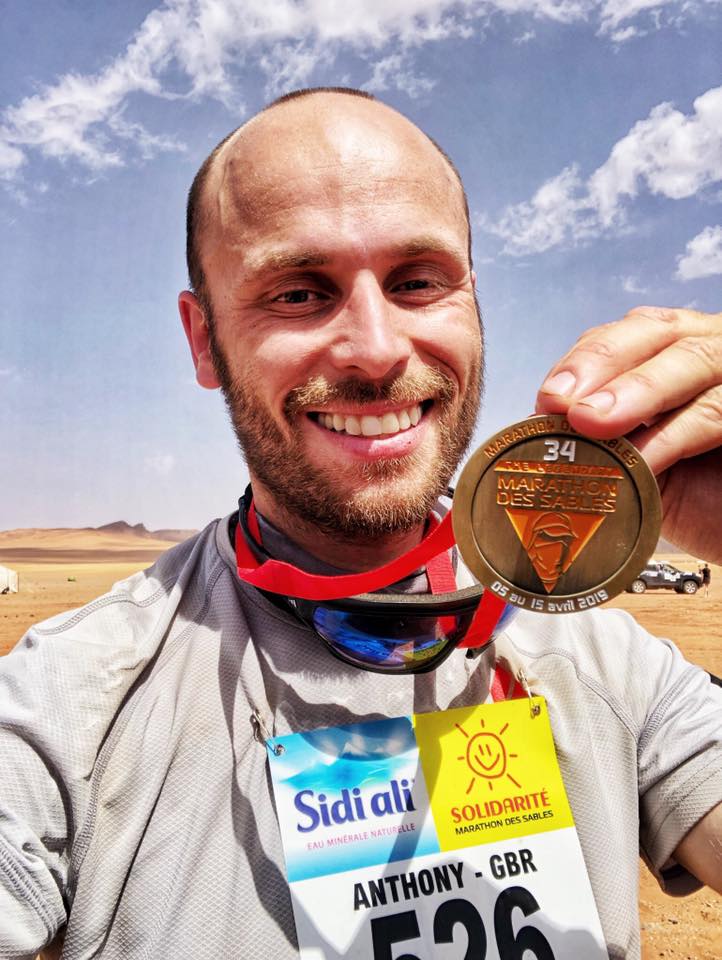
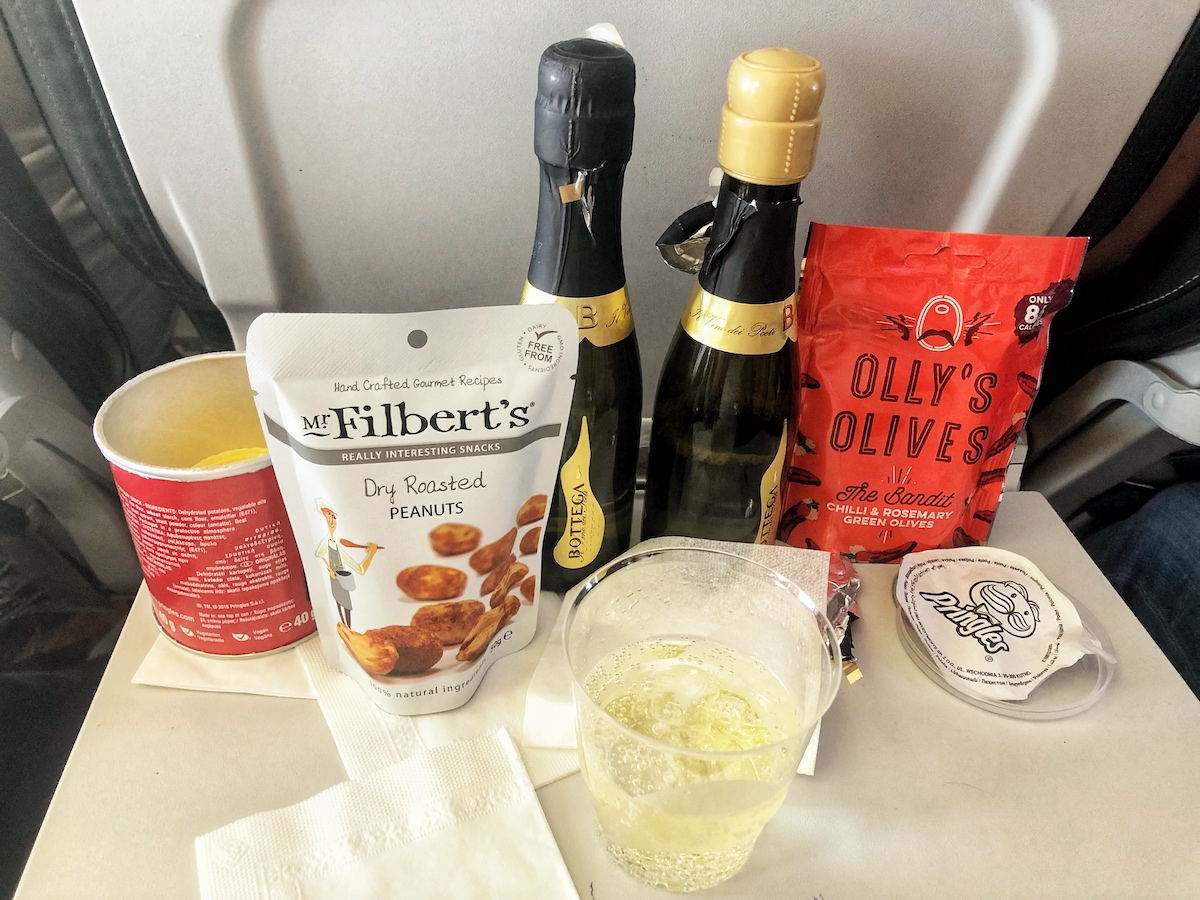
In a weird way, as I write this post on a flight (brain fuelled by champagne and pistachios), I’m a little sad that it’s over. The ending of a beautiful chapter of any impassioned story always has the potential to make us feel like that – I don’t mean an anti-climax, but realising the absence of a heightened emotion that recently stripped us down to the bare bones of our humanity, leaving you with the surreal “did that really happen” feeling.
Would you consider running the Marathon des Sables? If so, are there any questions you’d like to be covered in a book about it?

